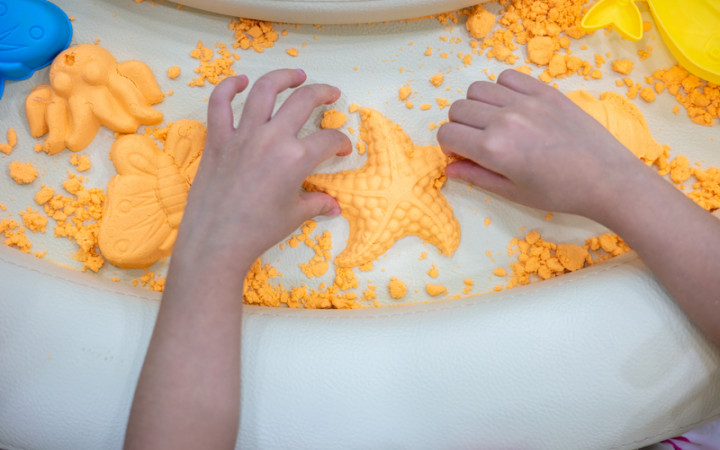Today’s Wonder of the Day was inspired by Brynlie. Brynlie Wonders, “What is inside of kinetic sand?” Thanks for WONDERing with us, Brynlie!
Have you ever played in a sandbox? Or with play dough? What about dipping your hands into gooey slime or sticky putty? Have you made oobleck or moon sand? All of these are fun materials for playing in different ways. Some you can make at home, and others you buy in a store. Today, we’re WONDERing about kinetic sand—how is it made? And just what IS kinetic sand?
Kinetic sand is mostly sand—98%, in fact. The other 2% is a compound called (poly)dimethylsiloxane. Another word for this compound is dimethicone. You’ll find dimethicone in many household items, like makeup, shampoo, and lotion. It is a form of liquid silicone. Kinetic sand is regular sand that has been coated in this liquid silicone. The substance makes the sand stretchy and feel soft. In short, it is what makes kinetic sand so much fun!
You may have already played with a silicone-based toy. Many popular putties have silicones as some of their top ingredients. These toys—including kinetic sand—are mostly intended for fun. However, they can also have more important uses. They can be used as sensory items, for instance. Some teachers or therapists also use them to help patients work on hand strength and fine motor skills.
If you have never used kinetic sand, you might be WONDERing, what makes it so special? Kinetic sand sticks together better than ordinary “dry” sand, the kind you might find in a sandbox or at the beach. It holds together in a similar way to wet sand—the kind you would use to make a sand castle. It is also very soft. Because it holds together well, it is also easier to clean up than regular sand.
Sometimes kinetic sand acts like a liquid, and sometimes it acts like a solid. In fact, it is a non-Newtonian fluid. There are many kinds of non-Newtonian fluids. But let’s go back—first off, what is a Newtonian fluid? Sir Isaac Newton, a very famous scientist, described how fluids work. Think about water. It has a steady rate of flow and it acts in predictable ways. No matter how much you mix water around, it stays the same. Only temperature changes water, by making it into a solid (ice) or a gas (steam). Water is a Newtonian fluid because it follows Newton’s rules about fluids.
Now think about some other fluids. You may know that if you mix up cream, it will thicken and become whipped cream or butter. Cream is a non-Newtonian fluid. If you mix up honey, on the other hand, it becomes thinner and easier to pour. Things like shampoo, egg whites, and even blood are non-Newtonian fluids. They do not follow Newton’s rules for fluids.
Non-Newtonian fluids are often fun to play with. You may have played with “oobleck”—or a mixture of cornstarch and water. It can feel hard like a solid, or soft like a liquid, depending on how you touch it. Kinetic sand, too, changes how it moves. When you press down on a square made of kinetic sand, it will crumble. If you cut the same square with a knife, the sand will stay together. How does this work? It has to do with how the silicone is structured. That’s also why many toys, like putty, containing silicone are also non-Newtonian fluids.
Is there more science to kinetic sand than you thought? Take a look around your home or school—what can you learn about how other toys work?
Standards: CCRA.W.7, CCRA.W.8, CCRA.W.9, CCRA.SL.2, CCRA.SL.4, CCRA.SL.5, CCRA.L.1, CCRA.L.2, CCRA.L.3, CCRA.L.4, CCRA.L.5, CCRA.L.6, NCAS.CR.1, NCAS.CR.2, NCAS.CR.3, CCSS.SMP.1, CCSS.SMP.5, NGSS.LS1, NGSS.PS1, NGSS.PS2




